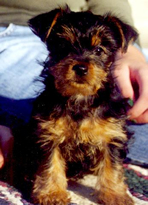
The Yorkshire Terrier is a single-coated breed of dog that has a long, straight,
flowing coat. It has a compact body, a relatively small flattened head and
small V-shaped ears that stand erect or half erect. Its medium length docked
tail is carried fairly high. A pet that was in fashion with Victorian ladies,
the Yorkshire Terrier carries itself in a confident manner that suggests vigor
and self importance. Its first appearance was at a bench show in England as
the “Broken-Haired Scotch Terrier” as it was originally brought
by Scottish weavers who migrated to Yorkshire in England. It became known by
its present name after it was noted that the breed has gained considerable
improvement in Yorkshire. Yorkie is its most common nickname.
Life Expectancy:
12 to 15 years
Energy Level:
Average.
Living Conditions:
Flexible; adapts to city and rural life
Barking:
Average.
Exercise Needs:
Minimal; regular walks.
Breed Group:
Toy
Size:
Small
Height:
8 to 9 inches
Weight:
4 to 7 pounds
Standard Hair Colors:
Puppies are born black and tan and are usually darker in color. Dark, steel
blue silky coat from the back of the head to the base of the tail and a golden
tan head, ears legs and chest.
National breed club:
Yorkshire Terrier Club of America
Early Yorkshire Terriers were previously used to catch rats in mine shafts and as hunting dogs that could easily penetrate badger and fox burrows. As the breed gradually miniaturized over the years, it became a fashion dog, a live “accessory” which women especially of the Victorian era would carry in their bags and under their arms. Although quite a favorite at dog shows because of its lustrous coat and high trainability, the Yorkie makes an excellent watchdog, ready to defend its territory when needed. They are now more commonly kept as house pets.
A Yorkshire Terrier has a playful disposition and is generally tolerant of children provided they maintain respect for its territory. It gets along well enough with cats and other household pets but exhibits occasional aggressiveness with larger dogs. It can become very attached to its human family but it should not be excessively pampered as doing so actually confuses it. The tendency of owners to overprotect the dog may be due to its size which makes it appear as delicate. Care guided by common sense will suffice considering that this breed is after all a little terrier.
The exercise needs of a Yorkshire Terrier are uncomplicated as it can easily adapt to the activity level of its owners in the same way that it adapts to its surroundings. However, regular opportunities to run and play are quite beneficial to the dog.
Apartment life is quite suitable for a Yorkshire Terrier. Although it is quite partial to long walks that country living can afford, it is able to adapt to all lifestyles and live in a reduced space. The breed can be sensitive to the cold weather and shows much preference for warm climates.
Brushing and combing of the Yorkshire Terrier’s coat should be done on a daily basis. Both the owner and the dog can benefit from a professional trim to keep the hair at a manageable length. A bow or a rubber band can be used to keep the hair away from the eyes. The ears should also be checked regularly, removing all loose hairs from the ear passages. However, full show coats will entail several hours of grooming.
Extra tiny dogs are very susceptible to health problems, hereditary or otherwise. Falls and knocks can easily cause fractures of bones for the Yorkshire Terrier. Health concerns may include severe skin problems, allergies, hair loss, long term illness, bronchitis, early tooth decay, poor tolerance of anesthesia, delicate digestion and problems concerning the spine.
For more information on yorkshire terriers you should consider building a relationship with a local breeder who breeds purebred puppies. Good breeders love their breed and are happy to answer any questions you might have. By talking with several good yorkshire terrier breeders you can get a fuller knowledge of the breed and a range of the price you should expect to pay for a yorkshire terrier puppy.
You should always get your new dog from a reputable breeder or adopt from a shelter or rescue. The Dog Guide strongly advocates for dog adoption. If you'd like help training your new yorkshire terrier, feel free to check out our articles on dog training.
...you might consider the Maltese which is a very small white Spaniel kept as a lapdog since the times of ancient Greece and Rome. If you have the patience for grooming the Yorkshire Terrier, then you will not have any major problem with a Maltese’s very long silky hair. Both breeds indulge an owner’s need to pamper and show off their dogs.

Copyright © 2005-2016 Pet Information All Rights Reserved
Contact us: www162date@outlook.com